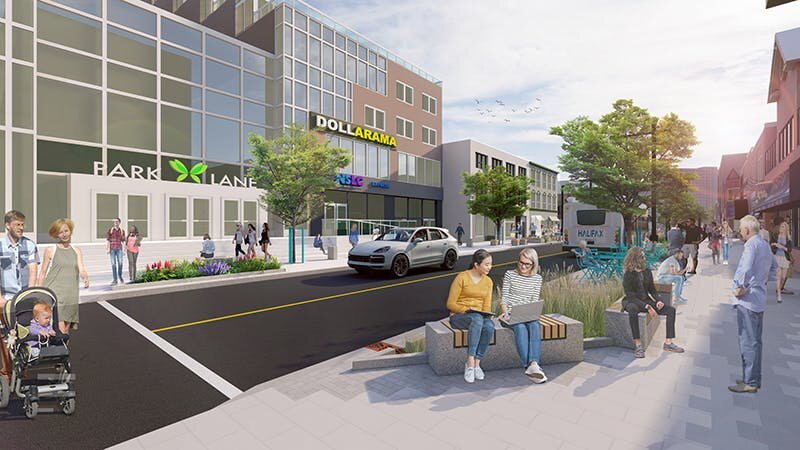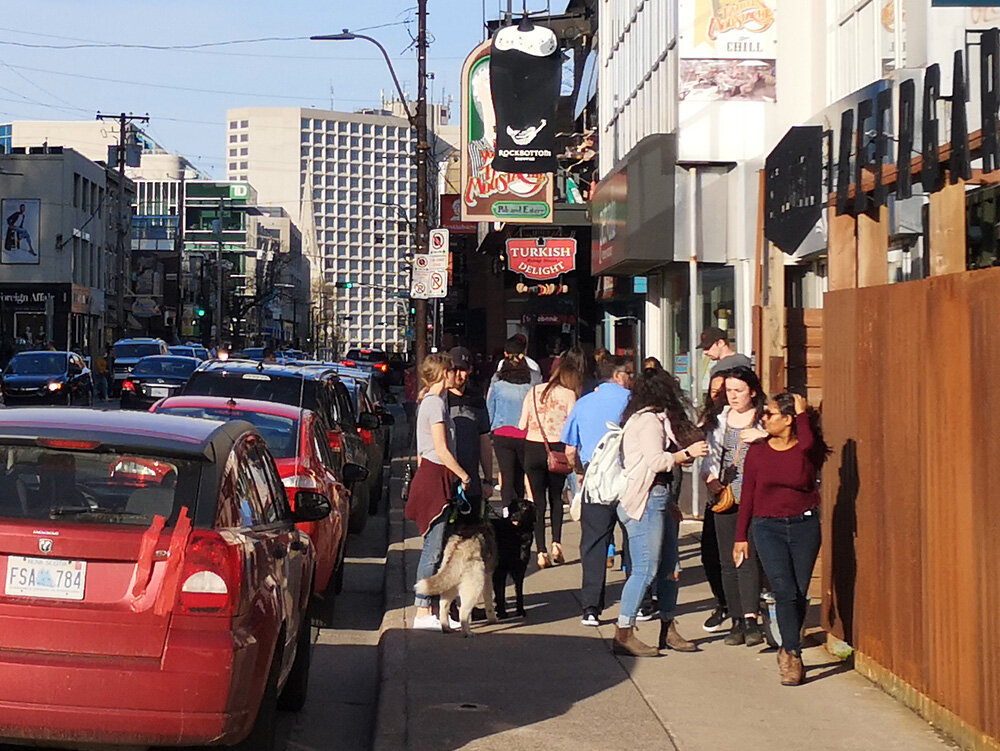The Ever-Improving City
Imagine a city that gets better at everything you use it for. Walk on a street everyday? Soon new benches and flowers appear there. Use a bus? It starts arriving more frequently. There’s a park you like to relax in? Soon it has a new fountain and trees.
Now imagine if this city responds to everyone’s habits in this way. Year after year, bit by bit, the city would become better adapted to its residents. It wouldn’t be a perfect city for everyone, but it would be the best-possible city for the specific people who live there.
This vision is at the heart of what we mean by a “Strong Town.” We call the method “incrementalism,” and it’s a radical departure from standard planning procedure today, in which professionals design streets for what they think people will want or need. This article offers a few simple insights on how to create an ever-improving city, and why it matters.
Streets and Adaptation
When you look at empty streets at 5:00 a.m. in your city, can you tell which sidewalks are the most popular during the day? Ideally, the busiest sidewalks would be widest, to accommodate everyone walking. If that were true, it would be obvious which sidewalks are most popular. But often, the only clue that a sidewalk is popular is litter and dried gum.
This sidewalk, below, is the busiest pedestrian street in Eastern Canada, and often, people barely fit. No matter how much foot traffic increases on this street, the sidewalk has never grown an inch.
Or take this bus stop on the same street. It is one of the busiest stops in the city, but you would never guess. It has no bench, no transit map, no art, little protection from the elements, and certainly no display indicating the next arrival time. The bus stop would look the same if it were used by almost no one.
The Human Body and Adaptation
The human body works differently. You could probably tell which of the athletes in these photos is a shot-putter and which is a marathon runner, even if they were at home in their pajamas. When we use our bodies to do something, they physically adapt and become better at it. Why don’t our cities?
Left, a marathon runner, Wikimedia Commons. Right, Gaëtan Bucki, Wikimedia Commons.
In some ways, it’s frustrating that our bodies adapt to what we do, not what we want. Life would be simpler if we could decide to become a marathon runner, and our bodies would grow muscles based on that intention. Why can’t we consciously plan our bodies the way we plan our cities?
However, there is wisdom in how we evolved. What we consistently do month-after-month, year-after-year, provides a better prediction of our future than what we think we will do. Compare New Year’s Resolutions to how people actually behave by March.
Similarly, if a city aims to benefit the maximum number of people in the future by investing in sidewalks today, the most-reliable bet is the sidewalks that lots of people already use.
Adaptation Disorders
Imagine if you had a body that didn’t adapt. You could run everyday for a year but still couldn’t run any farther. Some people do have this problem. I’m not aware of a name for this condition, but for cities, we can call it an “adaptation disorder.” Everyone walking on Spring Garden sends a signal that the sidewalk needs investment, but nothing happens. It’s like people are pressing a button that says “change,” but the button is broken.
Soon, Spring Garden will finally receive investment, but not the small changes it has needed for decades. Instead, the street will be replaced with a whole new $10 million design. The project looks like a major upgrade and the street no doubt deserves the investment. However, this renovation will not cure the street’s adaptation disorder.
Spring Garden’s new design looks like a major upgrade. Like most streetscaping projects, however, it will be shaped by someone drawing on a screen, and not by how people use the space.
Imagine standing on Spring Garden at 5:00 a.m. in 2025, once the renovation is complete. It still won’t be possible to tell which sections of sidewalk people use the most, which bus stops are busiest, or which benches are warmest from frequent use. Nothing will be shaped by how people use the space. Everything will still be shaped by someone drawing on a computer screen back in 2019.
Will the renovation pay for itself? Maybe. It might be wildly successful. Or it may accidentally erase something that makes the street successful today. In short, we don’t know—it’s a gamble. The difference between an adaptation and a gamble is this: does it respond to what people do, or to what we think they might do?
Participation Isn’t Good Enough
When Halifax redesigned Spring Garden, it consulted the public. Often, urban planners assume that public consultation is the key to adapting a plan to a local community. However, public consultation does not fix the adaptation disorder. The street designed with consultation is still, ultimately, shaped by someone drawing with a mouse.
Consider how much information a public consultation offers: a few pages of comments from a small subset of people, describing what they think they would probably like. Compare that to the information revealed when thousands of people walk on a street month-after-month, year-after-year.
Spring Garden Road during the day. Large crowds are often tightly packed on a small sidewalk.
Businesses and Adaptation
At 5:00am, there is one way you can tell Spring Garden is a busy street: nearly all its windows contain businesses. The street has a bookstore, an electronics store, barbers, a grocery store, restaurants, bars, clothing stores, banks, cell phone carriers, and much more. These would not exist if the street weren’t popular.
There is an important similarity between businesses and the human body. If you run a lot, legs get bigger. If people drink lots of craft beer on bar patios, soon the street has more craft beer and patios. Any business with an adaptation disorder would soon disappear. Consider that if all residents near Spring Garden moved away, and thousands of people from Argentina moved in, the products on store shelves would soon change, and many businesses would be replaced by new ones.
Streets like Spring Garden succeed because their businesses adapt, and overtime, they become finely tuned to the local needs, quirks, and habits of the people who live there. In this way, a local main street can become a unique place, reflecting local culture.
The contents of stores change flexibly in response to what we need, while the design of main streets are so-often frozen in time. The solution, of course, is not to privatize the sidewalk. But we can learn one thing from business: for cities to thrive, they should adapt constantly to what their residents do.
A busy summer day on Spring Garden Road.
An Adaptive Approach to Design
Strong Towns readers will be familiar with the kinds of mechanisms cities can use to constantly adapt a street to their needs:
Measure where people walk, linger, and sit in a street or public space. Re-invest in the places that are most useful for people (á la Jan Gehl).
Invest in the bus stops that people use most.
Invest in the bike lanes people use most.
Experiment with low-cost, temporary changes in infrastructure to reveal what people will use, and what they won’t, before investing in permanent infrastructure.
Increase transit frequency on the most popular lines. Eventually, reinvest in infrastructure on those lines, so that, over time, bus routes may become bus lanes, which can become trams, which can become subways.
Implement zoning rules and a tax system that incentivizes developers to similarly reinvest in the places that are most valuable for people.
Happily, Halifax is shifting increasingly to an incremental approach to street design. The Spring Garden project did involve some experimentation, and, optimistically, perhaps the new design can act as a base layer, which the city can then adjust incrementally. Time will tell.
Can a city afford such ongoing improvements? In fact, if we measure the cost per user, these are, by definition, the most cost-effective interventions a city can make. A better question is: can a city afford benches that no one uses?
And, moreover, can a city afford to not invest in its most-popular streets? Successful main streets often pay for a large share of a city's budget. Letting these places stagnate does not improve the city’s finances.
This article focuses on reinforcing success. However, a separate set of tools are essential for repairing failure. Perhaps no one uses a local park, sidewalk, or bike lane because there are barriers that can be fixed. However, reinforcing success and repairing failure require two very different kinds of analyses. Both are important, and they should each have their own budget.
A city can only reinforce success or repair failure if it gathers data on what residents use, and what they don’t. This is, perhaps, the only area of work in which “smart city” sensors would be legitimately helpful, rather than a gimmick. Old-school observational studies can also do the job. The rewards for these measurements would be huge: a city that matches its residents.
Storing Knowledge in the Physical Shape of the City
Where is the best place to store a city’s knowledge about what sidewalks and benches people use most? Maybe on a website, or a GIS map?Here’s an alternative: store the information in the sidewalks and benches themselves. When we design streets in response to how people use them, the streets themselves describe how people use them.
If you continue adapting streets for decades, you eventually store decades of knowledge in their design. This matters, because cities are too complex for any individual to fully understand. If we adapt infrastructure to what all residents do, we can create a system that, overtime, better represents what is useful for people. In this way, we can make a city that is smarter than ourselves.
A Strong Town is directly shaped by its residents’ daily needs. Its bricks, concrete, and asphalt express what kind of people live there, where they spend time, where they gather, what they need, who they are. The history of a place is recorded directly in its form, because it is shaped by residents’ behaviours — not by someone’s theory about what people likely want. Every town can be a Strong Town, but only if we reform planning to follow what people do.
About the Author
Tristan Cleveland is an urban planner with Happy City. He is also a PhD candidate at Dalhousie University's Healthy Populations Institute, studying how to ensure communities are designed to support human health.
You can connect with Tristan on Twitter at @LUrbaniste.










The era of corner stores and mom-and-pop shops has mostly come to an end, with modern zoning codes strictly segregating commercial and residential areas. But a return to the mixed-use model might be just what we need to empower entrepreneurs and strengthen people's sense of community.